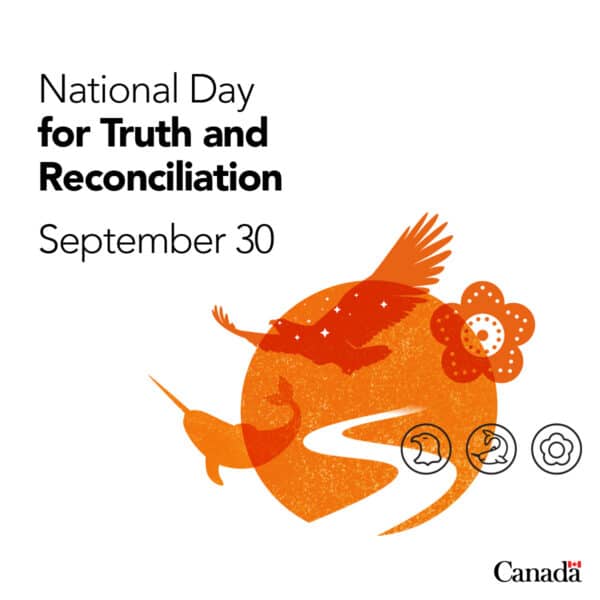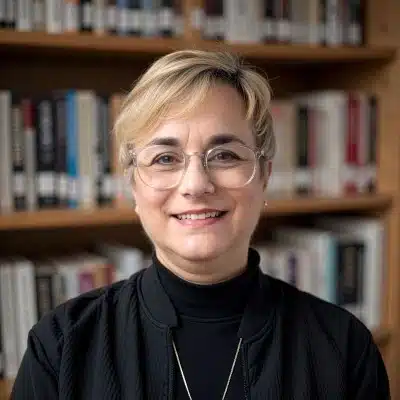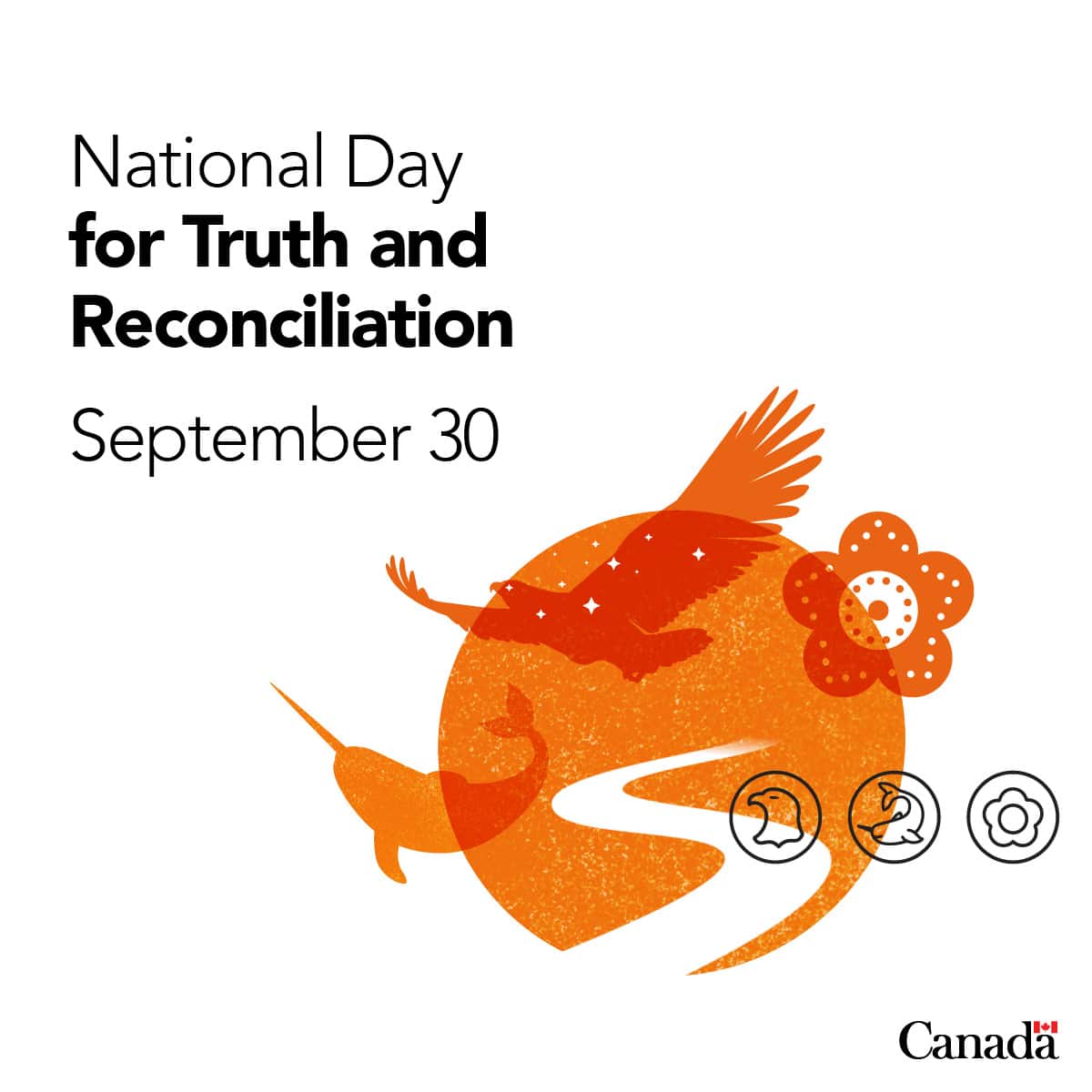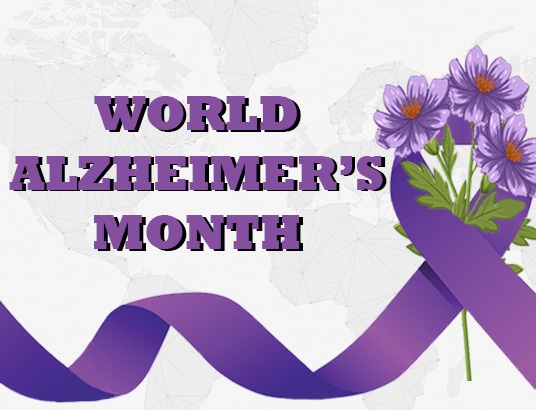By Krystal Murray Allen
“Each time I acknowledge the traditional lands upon which I live, or put on my orange T-shirt, I think of my family, and our collective gratitude for our First Nation neighbours, including, The Ellsworth family, who love/loved our youngest son and cared for him in life and in death. When Geordie, was 30 years old, he died in a hunting accident. They were there to grieve with us – to visit, sit with us, share memories, cry with us, and cook for us. Together with some of the kids he coached on a lacrosse team, they offered to drum at his funeral. And drum they did! They drummed his body into the church, into the chapel, and up to the front. They drummed his body out to the hearse. And they stood with us, shared our sorrow, and witnessed our suffering.” Kath Murray
Back to School, Back to Loss
As we enter the back-to-school season, it can be filled with so much positive anticipation. However, back to school has meant entirely different things to the Indigenous communities in Canada. Back to school is much more complicated when you, your parents, and their parents were forcibly sent to residential schools each September. It becomes a season of loss. A season of grief carried and grief yet to be carried.
As the back-to-school season comes to a close we now have the opportunity to shift gears. Instead of leaving it as a season of loss, perhaps it can be a season for healing. On September 30th we are given the opportunity to observe the National Day of Truth and Reconciliation. It is a designated day for every Canadian to seek the truth about residential schools, and to take action to reconcile.
This article is intended to provide a very brief introduction and refresher on the legacy of residential schools, ideas about how to make the Day of Truth and Reconciliation meaningful and impactful and I will include my family’s plan for this year. I welcome your thoughts on what you might be doing to further the calls to action.
A very brief history of the legacy of Residential Schools
Funded by the Government of Canada and administered by various Christian churches, residential schools were created as a system to assimilate the Indigenous population of Canada. Residential schools were the boarding schools in which Indigenous children were removed from their homes and kept separate from their families, culture, language, and spiritual practices. Some schools predate Canadian Confederation; there are records of day schools existing in the 1600s. However, boarding schools became mandatory in 1876.
Over 150,000 children were placed in schools across Canada. The last one closed in 1997. According to the United Nations Declaration of Indigenous Rights, the practice of assimilating a people by removing children from their family is genocide. Not only were they kidnapped, but the children commonly received horrendous abuse from those who collected and boarded them. The abuse was extensive and too often led to death. This system, created by imperialists and executed by Christian churches has been recognized by the Canadian House of Commons and Pope Francis as genocide.
Walking Toward Truth: Reflections on Reconciliation in 2025
As part of the class action settlement, known as the “Indian Residential Schools Settlement Agreement”, funds were set aside for uncovering and sharing the truth of what occurred at the residential schools. To bring to light the effects the schools had on the children and their families. Some of the funds went towards establishing a special commission. The Truth and Reconciliation Commission (TRC) was mandated to inform all Canadians about the residential school system and its enduring consequences. After years of collecting data the TRC put forward 94 Calls to Action.
Answering the Calls to Action – Individually and Collectively
Most of the calls to actions address organizations. This can leave individuals not knowing how to answer the calls to action. I have felt that way. However, I have found some ways that have helped me. I recommend everyone to:
- Study the Calls to Action. Don’t just read them, print them off and make notes to assist in your comprehension and retainment.
- Reflect on these calls to action and identify which organizations you associate with.
- Advocate within those organizations for those calls to action to be addressed with action, not just words.
Palliative Care and Education: Where Action Begins
Many of you reading this are involved in palliative care and/or education. Both the medical system and the education systems were called to action in the TRC report. Items 18-24 call the medical community to action. Items 6-12 and 62-65 call the education systems to action. You will most likely find a call to action that you can act on. I found one I could act on.
Item 22 calls all who can affect change in the Canadian health-care system to recognize the value of Aboriginal healing practices and use them in treatment of Aboriginal patients, in collaboration is Aboriginal healers and Elders where requested by Aboriginal patients (Aboriginal is a government assigned term for Indigenous people).
When I was an LPN, I advocated for item 22 to be acted on. My unit had an Indigenous patient admitted. They were quite ill and required palliative care. Their family gathered at the bedside. As I have witnessed in many cultures, family gathering at the bedside is often acceptable and encouraged. However, when my fellow nurses expressed irritation over the extensive number of visitors and the late hour of their visits, I chose to advocate that this was their traditional medicine. That gathering everyone together was essential for the patient’s and family’s wellness. I helped the nursing staff recognize that aunties, uncles and cousins might be blood and non-blood related and could be just as essential to the patient. To their credit, the nurses took action to support the patient and their family. We collaborated with the family to create the space for their entire extended family to stay and visit as long as the patient needed, while also ensuring the wellness and privacy of our other patients.
Bearing Witness: A Family Tradition
This year, my family will be attending a gathering where residential survivors and their families have the opportunity to share stories and reflections. This will be our fourth year. Every year has been different, but always powerful. My children look forward to it. Last year, my eldest daughter understood some of the details of abuse the survivors experienced. It landed deeply in her mind and heart. She knew things had happened – bad things. However, when she heard the woman tell her story it became real. It became more important. It became current news, not history. It is essential for everyone to hear the truth. How can we reconcile if we are oblivious to the living impact? I hope these experiences will help my children move reconciliation forward with sincere and informed action.
Learning and Listening: Tools for Reconciliation
This summer, I discovered a phenomenal book about reconciliation. David A. Robertson is a member of the Norway House Cree Nation and is an award-winning author, podcaster, public speaker, and advocate. One of his latest books is called “52 Ways to Reconcile: How to Walk with Indigenous Peoples on the Path to Healing”. It can be purchased in stores and online. Click 52 Ways to Reconcile to purchase his book. It is much like Life and Death Matters’ educational tools. It presents complex situations while providing actionable recommendations. The book is clear and concise, yet personable and genuine. The book walks through an item per week for 52 weeks. These items clearly outline ways individuals can move reconciliation forward.
On reflection, this is how I will be responding to some of David’s invitations:
#18 I will finish watching “Reservation Dogs” and “North of North,” both TV shows currently available on Netflix.
#9 I will build a playlist of Indigenous musicians and musical artists, I had been wanting to for a while, but his invitation helped me set the goal.
#17 I will continue to buy amazing streetwear from “Section 35”. It is an Indigenous owned company. It fuses modern style with nods to Indigenous roots that spark learning about Section 35 of the Indian Act. The designer sells online, but has set up an amazing store in Chilliwack, BC.
#46 Instead of asking for instructions on reconciliation, I will find my own. I can look up books, authors, read the calls to action, respond to requests and do my own research. My Indigenous friends are not my reconciliation coaches. I am smart. I have access to resources. I care enough. I can keep learning.
#52 I will continue to share David’s book. I recommend this book to anyone wanting to take reconciliation seriously.
In Closing
When I was an LPN I found that palliative care was set apart from other nursing areas. It was a place where I could slow down, collaborate, take the lead from the patients’ needs and wants, counsel with family, remove hierarchy, challenge the culture of Western medicine, care for the whole human, and value the hard work of dying while living. In reflection, I find it was the most decolonizing area of Western medicine I have ever worked in. I loved it! I am honoured that I was asked by Life and Death Matters to share my thoughts on the TRC and the National Day of Truth and Reconciliation. I wish the very best to anyone trying to navigate the back-to-school season. I am thrilled that we all have an invitation to find and act on the truth of residential schools this September 30th. May you each find a meaningful way to participate.
Support for Survivors
For survivors and their families, reading materials such as this can generate feelings that may benefit from having additional support. 1-866-925-4419 is a 24-hour crisis line that provides emotional support for those affected by the residential school system.






